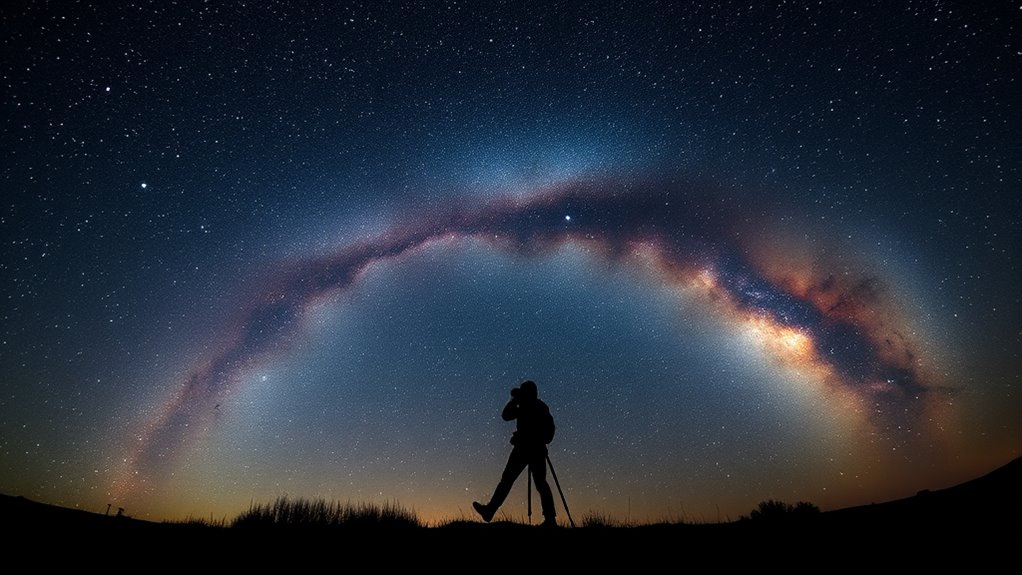If you’re looking to capture stunning Milky Way images in 2025, I recommend checking out the VILTROX 75mm f/1.2 PRO for Sony APS-C, the VILTROX 75mm f/1.2 XF for Fuji X cameras, the AstrHori 6mm F2.8 fisheye for Nikon Z, the Sony E 16mm F2.8 wide-angle prime, and the 78 D Double Aspheric lens. These options combine wide apertures, excellent light-gathering, and durability to help you shoot like a pro. Continue exploring to discover the best fit for your night sky adventures.
Key Takeaways
- Opt for lenses with large apertures (f/1.4–f/2.8) to maximize light intake and minimize exposure times in low-light conditions.
- Choose wide focal lengths (14mm–24mm) for expansive sky coverage and better framing of the Milky Way and landscape.
- Prioritize high-quality optics with minimal distortion, chromatic aberration, and excellent sharpness at wide apertures for detailed astrophotography.
- Ensure lens compatibility with your camera system, focusing capabilities (preferably manual focus), and features suited for night photography.
- Consider durability features like weather sealing and robust construction for outdoor night shoots in challenging conditions.
VILTROX 75mm f/1.2 PRO E Lens for Sony APS-C Cameras
If you’re serious about capturing stunning Milky Way shots with your Sony APS-C camera, the VILTROX 75mm f/1.2 PRO E Lens is an excellent choice thanks to its ultra-bright f/1.2 aperture. This lens excels in low-light conditions, allowing you to shoot with higher shutter speeds and lower ISO settings for sharp, detailed images. Its 75mm focal length is perfect for capturing starry landscapes and isolating celestial details. Built with 16 elements in 11 groups, it delivers high resolution and beautiful bokeh. The fast autofocus, sturdy all-metal construction, and compatibility with various Sony models make it a versatile, reliable tool for astrophotography.
Best For: photographers and astrophotographers seeking a versatile, bright prime lens for portraits, landscapes, and night sky capturing with Sony APS-C mirrorless cameras.
Pros:
- Excellent low-light performance with f/1.2 aperture enabling sharp images in dim conditions
- High resolution and detailed images thanks to 16 elements in 11 groups, including high-refractive index lenses
- Fast, quiet autofocus suitable for both stills and video, with manual override options
Cons:
- Heavier weight due to all-metal construction may be less convenient for handheld shooting
- Limited focus breathing compensation, which can affect video work
- Some users experience vignetting and minor compatibility issues with older Sony models
VILTROX 75mm f/1.2 XF PRO APS-C Lens for Fuji X Cameras
Looking for a lens that excels in low-light conditions and produces sharp, stunning images of the Milky Way? The VILTROX 75mm f/1.2 XF PRO APS-C lens for Fuji X cameras is perfect. Its large f/1.2 aperture gathers plenty of light, ideal for astrophotography. With 16 elements in 11 groups, including high-refractive index glass, it delivers crisp, detailed images even at wide apertures. Fast, quiet autofocus with manual override makes it versatile for both stills and video. Compatible with popular Fuji X-mount models, this lens offers durability, electronic aperture control, and USB upgradeability—making it a great choice for capturing the night sky with professional quality.
Best For: photographers and videographers seeking a high-performance lens for low-light, portrait, landscape, and astrophotography with Fuji X-mount cameras.
Pros:
- Large f/1.2 aperture ideal for low-light and creative depth-of-field effects
- Excellent resolution and sharpness across the frame with 16 elements in 11 groups
- Fast, quiet autofocus with manual override, suitable for both stills and video
Cons:
- 75mm focal length may be less versatile for general everyday photography
- Heavier and larger compared to standard lenses, which might affect portability
- Premium features and build quality come at a higher price point
AstrHori 6mm F2.8 Circular Fisheye Lens for Nikon Z Mount
The AstrHori 6mm F2.8 Circular Fisheye Lens for Nikon Z Mount stands out as an ideal choice for astrophotographers seeking to capture the entire night sky in a single shot. With its 220° ultra-wide field of view, it produces immersive, circular images perfect for Milky Way and starry sky photography. The large F2.8 aperture guarantees excellent low-light performance, while manual focus provides precise control. Its compact, durable all-metal body makes it travel-friendly, suitable for outdoor adventures. Designed specifically for Nikon Z full-frame mirrorless cameras, this lens offers a creative tool to elevate your astrophotography and artistic projects.
Best For: astrophotographers and creative artists seeking to capture immersive, full-circle night sky images with excellent low-light performance on Nikon Z full-frame mirrorless cameras.
Pros:
- Offers an expansive 220° ultra-wide circular fisheye view for dramatic and immersive images.
- Large F2.8 aperture ensures superior low-light performance and beautiful background separation.
- Compact, all-metal construction provides durability and portability for outdoor and travel photography.
Cons:
- Manual focus may require additional skill and time to achieve precise results.
- Designed exclusively for Nikon Z mount cameras, limiting compatibility with other systems.
- Bulky dimensions for a fisheye lens may be less convenient for everyday carry and quick setups.
Sony E 16mm F2.8 Wide-Angle Prime Lens
For astrophotographers seeking a lightweight, wide-angle lens that excels in low-light conditions, the Sony E 16mm F2.8 is an excellent choice. Weighing just 67 grams and measuring 22.5mm, it’s highly portable and perfect for Milky Way shots on the go. Its bright F2.8 aperture delivers solid low-light performance and beautiful background blur. The lens offers sharpness across the frame thanks to aspherical elements, with minimal distortion. Plus, it’s compatible with Sony conversion lenses for expanded creative options. Its quiet autofocus and close focusing distance make it versatile for capturing wide-angle night sky scenes, all in a compact, travel-friendly design.
Best For: hobbyist and amateur astrophotographers seeking a lightweight, wide-angle lens with excellent low-light performance for capturing night sky scenes and landscapes.
Pros:
- Ultra-compact and lightweight design, ideal for travel and outdoor photography
- Bright F2.8 aperture provides strong low-light performance and beautiful background blur
- Sharp optics with minimal distortion, thanks to aspherical elements, ensuring clear images across the frame
Cons:
- Autofocus may be slower and noisier compared to professional-grade lenses
- Limited close focusing distance of 0.24 meters, restricting macro or close-up shots
- Not intended for professional use, potentially lacking advanced features and durability
78 D Double Aspheric Lens
The 78 D Double Aspheric Lens stands out as an excellent choice for ophthalmic professionals seeking sharp, detailed images with an extended working distance from the cornea. Its double aspheric optics enhance image quality and clarity, making it ideal for precise assessments. With a 78 diopter strength, it offers a balanced field and magnification, providing flexibility during slit lamp examinations. Weighing about 5 ounces, it’s lightweight and easy to handle. Its design allows for better clinical visibility, and positive reviews reflect its effectiveness. Manufactured by KASHSURG, this lens has proven to be a reliable tool for detailed ophthalmic work, combining performance with user satisfaction.
Best For: ophthalmic professionals seeking high-quality, detailed imaging with a balanced field and magnification during slit lamp examinations.
Pros:
- Provides sharp, clear images with double aspheric optics for enhanced detail.
- Offers an extended working distance from the cornea, increasing clinical flexibility.
- Lightweight design (about 5 ounces) for easy handling and maneuverability.
Cons:
- Variations in specifications and color may occur due to ongoing research and development.
- Limited information on compatibility with different slit lamp models.
- Price and availability may fluctuate, and price matching is not guaranteed.
Factors to Consider When Choosing Wide-Field Lenses for Milky Way Photography

When selecting a wide-field lens for Milky Way photography, I consider factors like aperture size, focal length, and low-light performance to get the best results. Compatibility with my camera and how well the lens controls distortion also matter since they impact image quality. Understanding these points helps me choose a lens that captures the night sky with clarity and detail.
Aperture Size Importance
Choosing a wide-field lens with a large aperture is essential for capturing stunning Milky Way images. A wider aperture, like f/2.8 or even f/1.2, lets in more light, which is vital for revealing faint details in the night sky. It also enables shorter exposure times, reducing star trails caused by Earth’s rotation and resulting in sharper images. Additionally, a larger aperture helps you shoot effectively in dark conditions without raising ISO, minimizing noise. With an open aperture, you can achieve beautiful bokeh and starburst effects that enhance your photos’ aesthetic appeal. Overall, the aperture size directly impacts the brightness, clarity, and detail of your night sky captures, making it a key factor in selecting the right lens for astrophotography.
Focal Length Selection
Focal length plays a crucial role in shaping your Milky Way images, as it determines how much of the sky and landscape you’ll capture in your shot. Typically, wide-field lenses range from 14mm to 24mm, perfect for night sky photography. A shorter focal length, like 14mm, offers a wider field of view, allowing you to include more of the sky and foreground, creating dramatic, expansive scenes. Conversely, a longer focal length, such as 24mm, provides a more zoomed-in perspective, highlighting specific star formations or celestial objects with greater detail. Your choice depends on your desired composition—whether you want an all-encompassing vista or a focused view of particular sky features. Consider scene size, framing, and the level of detail you aim to achieve when selecting your focal length.
Low-Light Performance
The ability of a wide-field lens to perform well in low-light conditions can make or break your Milky Way shots. A lens with a large maximum aperture, like f/2.8 or wider, lets in more light, which is essential for capturing faint details. Fast lenses with apertures such as f/1.4, f/1.8, or f/2.0 cut down exposure times, reducing star trails caused by Earth’s rotation during long exposures. Superior low-light performance also depends on maintaining sharpness and contrast at maximum aperture without excessive chromatic aberration or softness. High-quality glass elements and coatings help minimize flare, ghosting, and reflections, ensuring clear images in darkness. When selecting a lens, look for models with minimal focus breathing and consistent performance across the aperture range for sharp astrophotographs.
Lens Compatibility Needs
Since compatibility issues can derail your Milky Way photography plans, it’s crucial to verify your lens matches your camera’s mount type, whether that’s Sony E-mount, Nikon Z-mount, or another system. Next, confirm the lens supports your camera’s sensor size—full-frame or APS-C—to achieve the desired wide-field effect. Manual focus capability is often preferred for astrophotography’s precise focusing needs. Additionally, check that the aperture is wide enough—f/2.8 or wider like f/1.2—for excellent low-light performance. Finally, verify that the lens’s focusing mechanism and electronic features are compatible with your camera’s firmware and autofocus system. Addressing these compatibility factors ensures smooth operation, better image quality, and a hassle-free experience when capturing the night sky.
Image Distortion Control
Choosing the right wide-field lens for Milky Way photography involves more than just focal length and aperture; controlling image distortion plays an essential role in capturing accurate and stunning night sky images. Lenses with minimal barrel distortion help ensure the stars remain sharp and true to their natural appearance. Using lenses with aspherical elements reduces spherical aberrations and edge distortion, keeping star points crisp across the entire frame. Selecting a lens with a low distortion coefficient ensures that celestial objects and straight lines aren’t warped, maintaining the scene’s integrity. While software can sometimes correct distortions, choosing a lens designed with minimal inherent distortion simplifies editing. High-quality astrophotography lenses also feature specialized coatings that further minimize chromatic aberration and distortion effects, delivering cleaner, more precise images.
Build Durability Factors
Durability is a crucial factor when selecting wide-field lenses for Milky Way photography, especially since outdoor conditions can be unpredictable. All-metal construction enhances resistance to shocks and environmental stress, making the lens more robust during outdoor shoots. Weather-sealed designs are essential for protecting against dust, moisture, and temperature fluctuations, ensuring the lens stays functional in tough conditions. Reinforced lens mounts and high-quality coatings reduce the risk of damage from regular use and exposure. The materials used, like hardened glass elements and rugged housing, directly impact the lens’s ability to withstand rough handling and harsh environments. Proper maintenance—cleaning and storing in protective cases—also plays a vital role in preserving the lens’s structural integrity and optical quality over time, ensuring it lasts for many night sky adventures.
Portability and Size
When selecting a wide-field lens for Milky Way photography, portability and size are key factors that can make or break your outdoor experience. Smaller, lightweight lenses are much easier to carry and set up in remote locations, allowing for more spontaneous shoots. Compact designs also reduce the overall weight of your camera bag, making long night sessions more comfortable and less tiring. Generally, portable lenses have fewer elements and simpler construction, which makes handling in the field easier. Their lower profile enables discreet shooting in dark or sensitive environments, avoiding unnecessary attention. While ultra-wide fisheye lenses tend to be larger, some are designed with portability in mind, striking a balance between a broad field of view and travel convenience.
Frequently Asked Questions
How Do Lens Aperture and Focal Length Impact Milky Way Image Quality?
Lens aperture and focal length are essential for capturing clear Milky Way images. A wider aperture (like f/2.8) lets in more light, making stars brighter and reducing noise. Shorter focal lengths (around 14-24mm) give a broader sky view, perfect for wide shots. I always prioritize fast lenses with wide apertures and shorter focal lengths to get the sharp, vivid night sky photos I want.
Are There Specific Lens Coatings That Improve Astrophotography Results?
Yes, specific lens coatings can definitely boost my astrophotography results. Anti-reflective coatings reduce ghosting and flare, especially when capturing bright stars against dark skies. Multi-coatings further minimize reflections and increase contrast, letting me capture sharper, more vibrant Milky Way images. It’s like giving my lens a filter for night sky clarity. Investing in lenses with these coatings makes a noticeable difference in reducing unwanted glare and enhancing overall image quality.
What Are the Best Lens Options for Astrophotography on Budget?
If you’re on a budget, I recommend the Rokinon 14mm f/2.8 or the Yongnuo 14mm f/2.8. Both are affordable, offer wide angles, and perform well in low light, making them great for astrophotography. You don’t need the most expensive gear to capture stunning Milky Way shots—these lenses provide excellent quality without breaking the bank. Just make sure to shoot at wide apertures for the best results.
How Does Lens Distortion Affect Star and Milky Way Detail?
Imagine stars stretching into lines across your photo—that’s lens distortion at work. It warps the stars and the Milky Way, making them look elongated or bent, which can ruin the detail and clarity I want. To get crisp, stunning night sky images, I choose lenses with minimal distortion. This guarantees the stars stay pinpoint sharp and the Milky Way’s intricate structure shines through without unwanted warps.
Can Lens Size and Weight Influence Handheld Astrophotography Stability?
Yes, lens size and weight definitely influence handheld astrophotography stability. Heavier lenses can be harder to hold steady, leading to more camera shake and blurry stars. I find that using a sturdy strap or tripod helps, but lighter lenses are easier to handle for longer exposures. When I shoot handheld, I prefer compact, lightweight lenses to reduce fatigue and improve stability, helping me capture sharper Milky Way images.
Conclusion
Choosing the right wide-field lens is like finding the perfect compass for a night sky adventure. I once struggled with blurry Milky Way shots until I switched to a wider, faster lens—suddenly, the universe opened up in my photos. Remember, your lens is your tool to reveal cosmic wonders. Trust your instincts, experiment, and soon you’ll be capturing the night sky like a true stargazer pro. Happy shooting!















